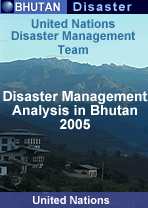|
Natural hazards in Bhutan
|
 |
Bhutan Glaciers - Glacial Lakes |
|
 |
Bhutan Glaciers - Glacial Lakes |
|
|
 |
|
Disaster Management Analysis in Bhutan
|
 |
Bhutan is prone to a number of natural hazards due to fragile geological conditions, steep sloping terrain, vulnerable ecosystem, great elevation differences, variable climatic conditions and active tectonic processes taking place in the Himalayas.
The following table shows the different types of natural hazards in Bhutan:
 Earthquakes; Earthquakes;
 Floods, including flash floods and glacial lakes outburst floods (GLOFs); Floods, including flash floods and glacial lakes outburst floods (GLOFs);
 Landslides; Landslides;
 Forest fires. Forest fires. |
 Outbreaks of pests and epidemic diseases; Outbreaks of pests and epidemic diseases;
 Droughts (local-level water stress); Droughts (local-level water stress);
 Wind, storms, hail, lightning. Wind, storms, hail, lightning. |
GLOFs
GLOFs are among the most serious natural hazards in the country. Under the influence of global warming, glaciers in the Himalayas are shrinking remarkably in comparison with other glaciers in the world. It is conceivable that glaciers in Bhutan under strong influence of the summer monsoon are very sensitive to the global warming and the glacier retreat is accelerating.
Glacier retreat leads to the formation of numerous supra-glacial and dangerous moraine-dammed pro-glacial lakes. These moraine dams if unstable could fail and give rise to GLOF events -resultant discharges of huge amounts of water and debris- often having a devastating effect downstream. The most common triggering event for a GLOF is a surge wave caused by mass movements due to large ice falls and avalanches, slope failures of lateral moraines, rock falls ordebris flows into the glacial lake, or seismotectonic events. Other triggering effects include overtopping of the dam crest due to lake overflow or intense seepage and piping.
According to the recent study carried out by the Department of Geology and Mines (DGM) in collaboration with the International Centre for Integrated Mountain Development (ICIMOD) , altogether there are 2,674 glacial lakes in Bhutan, among which 562 are associated with glaciers. The study has identified 24 glacial lakes as potentially dangerous lakes, i.e. lakes that could pose a potential threat of a GLOF in the near future
 |
Another study by the DGM along with the Institute of Geology, University of Vienna, Austria, warns of possible danger of Raphstreng andThorthormiglaciers and GLOF risk potential of their lakes, unless mitigation measures are taken. The worst case scenario is a combined GLOF of these two lakes, which could result in more than twice the volume of the 1994 GLOF with severe consequences downstream.
|
|
The impact of GLOF events downstream can be devastating in terms of damage to roads, bridges, hydro-power plants, trekking trails, villages, agricultural land, natural vegetation, as well as the loss of lives, property and infrastructure. Much of the damage created during GLOF events is associated with the large amounts of debris that accompany the floodwaters. Damage to settlements and farmland can take place at very great distances from the outburst source.
The following table presents a list of historical GLOFs events in Bhutan. Although several cases of GLOFs have been reported over the past few decades -for which records are mainly based on verbal information gathered from elderly people-, detailed written records of damage exist only for the 1994 GLOF.
 |
| Source: United Nations Disaster Management Team, 2005 |
| Information on Bhutan |
 |
|





